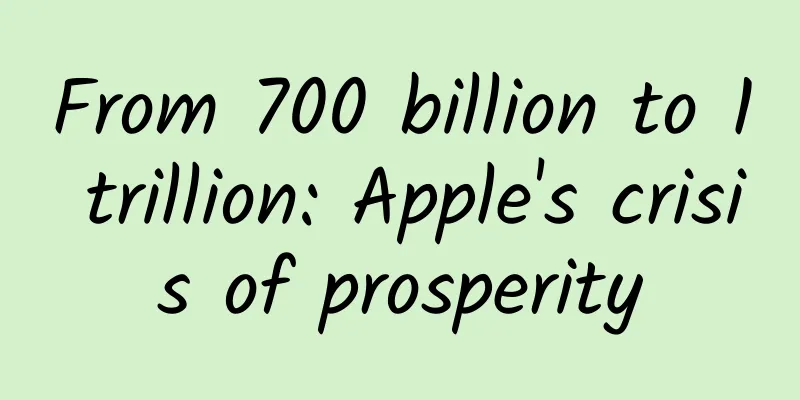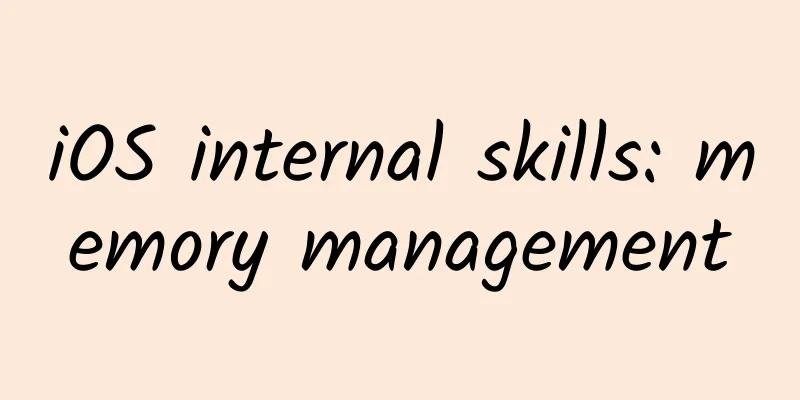From 700 billion to 1 trillion: Apple's crisis of prosperity

|
Apple's market value has exceeded $700 billion recently, becoming the first company in the S&P to have a market value of more than $700 billion. Many analysts say that Apple may become the first company to break through the trillion-dollar market value. We also see that in the three years that Cook has been Apple's CEO, he has successfully led Apple's market value to double and is about to reach a trillion dollars. For Apple CEO Tim Cook, who is eager to get rid of Jobs' shadow, he has succeeded. We know that Apple has taken nearly 80% of the profits in the mobile phone market. According to a survey by Michael Walkley, an analyst at Canaccord Genuity, Apple has taken about 86% of the profits in the smartphone market, while Samsung has taken about 18%. It can be said that Apple has basically ushered in its heyday today. As we know, no company can last forever, and Apple is no exception. What crises are hidden behind Apple's extreme glory? Apple faces market saturation in its heyday and lacks new business growth points to meet capital market expectations We know that, like people, a company will also have adolescence, youth, middle age and old age. When a company rises at the forefront, it can sweep the market and grow at a geometric rate through leading innovative technologies and business models. From the development history of Google, Facebook and Apple, we can see that they all occupied the market at a rapid speed in their youth and prime age. For example, Google has occupied 50% of the global market in 10 years (2008). But when a company that leads the entire industry develops to its heyday, it will inevitably be restricted by the entire industry. For example, the high-end market for smart phones is close to saturation in developed countries, and Apple has also encountered bottlenecks in software and hardware innovation. However, the capital market still has high hopes for this company. According to Zweig's law, at this time, the company must be able to foresee and be forward-looking about the saturation of the market, and constantly explore new business growth points or revenue points to meet the appetite and expectations of the capital market. For example, when Google's growth reached a bottleneck, it expanded from search-based AdWords advertising to content-based Adsense advertising. Apple, on the other hand, enlarged the screen size and launched the iPhone 6 plus to meet the needs of users in the Asian market and to take advantage of its competitor Samsung. Another option is to develop some new products to divert people's attention, such as the Apple Watch. Even Apple's chief designer Jonathon Ive spoke to the outside world through the New York Times, claiming that Swiss watches are in trouble and that Apple will subvert the watch industry. In addition to diverting people's attention, these also keep the outside world looking forward to Apple's innovation and pave the way for profits. It can also be interpreted as that when Apple, an innovative company, reaches the top in terms of technological innovation and financial growth, it will inevitably need to launch new businesses, products or models for the increasingly saturated market to meet the expectations of the capital market. We mentioned earlier that Apple expanded from search-based AdWords to content-based Adsense, and Apple increased its revenue by expanding the screen size and launching iPhone6 plus. From this, we can see that the role of genes is so powerful. Google is expanding its business and profit model based on the Internet, and it has always been centered around the core profit model of Internet advertising. This is Google's gene. Apple's business expansion, whether it is Apple Watch or plus, is based on hardware. In fact, whether it is PC to iPod, iPhone to iPad, Apple's business model has always been to sell software and hardware in packages and realize software profits through hardware. At the same time, in order to maintain the brand tone of fashion technology of the product, the hardware must maintain a high fashion technology brand tone to maintain the high value and high profitability of the hardware. Therefore, innovation is Apple's gene. Innovation can ensure that the expectations of the Wall Street capital market are constantly met and the capital market is optimistic about Apple, which will then drive Apple's stock price up, and this is crucial. But at present, whether it is the iPad entering the enterprise market or the Apple Watch is not optimistic about the industry, Apple currently lacks new models and product innovations to promote Apple's new business growth points. Large screens release pent-up demand, but crises are emerging: Android camp's strategy of flooding the market with devices recedes, and the company shifts to mid- to high-end devices Let's look back at iPhone 6. Is the popularity of iPhone 6 due to innovation? Obviously not. We can see that the iPhone 6 screen is not scratch-resistant and not waterproof, while the flagship phones of Samsung and Sony already have waterproof functions. Last year, iPhone 5S launched a 64-bit processor and fingerprint recognition. This year, many manufacturers in the Android camp have launched such models. At the same time, compared with the fact that Android platform opponents have entered the 2K screen era in advance, with the thinnest 5.1 mm, Apple's two new iPhones do not highlight the highlights of design, fashion elements and technological innovation in hardware. The large screen also follows the development trend and fashion of Android phones, but it appropriately releases the long-suppressed demand of iPhone users or potential users for Apple's large screen. But after this release of demand is met, what will Apple use to meet the growing demand of users? You know, Apple has raised the user's taste and expectations for Apple's innovation. Once the subsequent new products cannot continue to meet the expectations of users and the capital market, Apple will face a fatal crisis. On the other hand, the launch of iPhone 6 plus and the competition from the same door have weakened the user's demand for iPad, and there is no doubt that it has impacted the iPad business line. The decline of iPad business has been shown by multiple data sources. In addition, as mentioned earlier, Android platform rivals have entered the 2K screen era ahead of schedule, with the thinnest being 5.1mm. Apple's two new iPhones do not highlight the design, fashion elements and technological innovation in terms of hardware, and the iPad mini 3 has not changed in appearance, screen and configuration. The only highlight is the new Touch ID. It can be seen that after the industry has reached saturation, Apple's leading advantage has been continuously weakened, and Android platform manufacturers have more time and opportunities to continuously challenge Apple's leading position from all aspects and narrow the gap. We can see that when the demographic dividend is no longer there and the market is saturated, Android camp mobile phone manufacturers are undergoing a comprehensive transformation, and the strategy of "sea of machines" is facing a retreat. Samsung has recently made it clear that Samsung Electronics' smartphone models in 2015 will be reduced by 1/4 or 1/3 compared with this year, hoping to improve its price competitiveness. Huawei also said this year that it will "cut" more than 80% of its models and focus on the mid-to-high-end boutique strategy. Coolpad has recently unveiled its strategy of focusing on the mid-to-high-end market, and Lenovo has also launched new flagships such as the S90, focusing on fashionable design to build a reputation in the mid-to-high-end market. At the same time, China Cool Alliance continues to strengthen its advantages in patents to make up for its shortcomings and pave the way for impacting overseas markets. In the future, Android's full transformation to the mid-to-high-end market may not necessarily challenge Apple's position in the high-end market, but it is not impossible to gradually erode this part of the market share. iPhone is the only bright spot supporting Apple despite decline on many fronts Before 2010, Jobs once said that Apple is a tripod, supported by three main product lines, namely Mac, iPhone and iPod. But after the launch of iPad, the three main product lines became four. But we know that after 2010, the sales volume of iPod has been gradually declining. Currently, iPod sales account for less than 1% of Apple's total sales. In addition, iPad sales have been declining for three consecutive quarters. Recently, market research agency IDC also pointed out that Apple's iPad shipments this year are expected to be only 64.9 million units, a decrease of 12.7% from last year's level. On the other hand, Apple's soft power has also begun to decline, for example, the App Store has also begun to show a slowdown in growth. In fact, this is due to the fact that the smartphone market has reached saturation, the demographic dividend has disappeared, and the demand for software applications has also begun to decline. Apple's anxiety can also be seen from its recent rescue measures, which have reduced the price of many heavyweight applications and games to the lowest price - 1 yuan. If Apple has no innovative software and hardware business models other than iPhone 6 to reverse the downward trend of multiple revenue fronts, what new business can Apple use to meet the tastes and expectations of the capital market? It can be seen that although the iPhone 6 did not meet expectations, it still sold well. The essence is that the external factors lacked the subversive power to pry the Apple ecosystem, and the iPhone has become the only bright spot as the source of support for Apple's business and profits. According to data from research company Trefis, the weight of the iPhone accounts for 52.5% of the factors affecting Apple's stock price. As analyzed earlier, this is the only bright spot left for Apple. As the Android camp's smartphones collectively abandon the sea of machines to impact the mid-to-high-end market in the future, and strengthen the patent and supply chain system, this year Google released a new generation of Nexus 6, and then with the accompanying release of Android L, it began to gradually improve the actual experience of Android. In addition, as mobile phone users mature, they will form a more rational judgment on high-end mobile phones. It is hard to say that high-end market users will not form aesthetic fatigue with the iPhone in the future. The challenges Apple faces in the high-end niche market will become greater and greater. The battle for future scenarios: Apple's inherent weakness as a closed empire We know that Apple's founder Steve Jobs has adopted a relatively closed but relatively complete ecological chain layout from the beginning. In the 1980s, the Macintosh developed by Apple under Jobs' leadership was originally the leading IBM-PC machine running Microsoft DOS, but the closure led to Apple's decline. However, in the era of mobile Internet, Apple is still the same Apple. In the high-end niche market, it has eaten up the entire industrial chain from beginning to end, but this closed strategy is not conducive to Apple's advantage in the future scene battle. You know, Apple's future strategy is to connect everything, including cars, people, and homes. For example, Apply pay, which has been hotly discussed in the industry recently, can connect people and payments, Apple's Homekit hopes to "connect the family", Healthkit corresponds to "connect health", and CarPlay connects cars. Behind this connection of everything, it corresponds to the scene battle with Google. Today, Android has accounted for nearly 80% of the global smartphone market. Google now uses Android as the underlying core of the system to widely connect smartphones such as mobile phones, cars, wearables, home appliances, and notebooks with related smart hardware. Behind Android are more than 80% of the world's mobile phone users. A large number of users are the basis for connecting everything. In addition, the open alliance strategy adopted by Google's Android is conducive to absorbing the power of various links in the industrial chain to achieve equal benefits and make its own software products mainstream to create future scenarios. Apple's closed strategy with iOS as the core, in a closed niche market, eats up the entire industrial chain and obtains the greatest profit, but can only take about 15% of the global high-end smartphone market. The layout of connecting everything relies on a massive user base. In a closed niche market, it is not conducive to relying on the power of a broad industrial chain to promote its own software products to connect everything and fight for future scenarios. In addition, Google has more advantages in software layout, including many killer software such as Google Search, YouTube, Google, and Google Maps. It has advantages in Internet thinking and cloud technology, big data storage, computing and mining capabilities. In the layout of connecting everything, it can customize the services and products required by users based on data analysis, processing and monitoring based on user behavior. In the future battle of scenarios, the winner will inevitably be the mobile Internet platform and ecosystem that understands users best. Back to the proposition at the beginning, we know that many companies cannot get out of their own genes. For example, Apple has always been a closed system. It contributed to its rapid rise in its youth, but in its heyday, as the industry matured, it also limited its future expansion and connection to everything. Everything Apple is doing now is to make the iOS closed system more stable and the capital market recognize Apple's continued profitability. The capital market is gradually getting used to Apple's rapid growth, and Apple is also running hard under pressure. Perhaps Apple should not be thinking about how to break through the trillion-dollar market value or become a money-making machine to overdraw brand premiums, but should consider how to exceed the expectations of the capital market and users in product innovation, and then pave the way for the next new business growth point. Innovation is Apple's most important gene, and it is also the most effective way to continue Apple's heyday. As a winner of Toutiao's Qingyun Plan and Baijiahao's Bai+ Plan, the 2019 Baidu Digital Author of the Year, the Baijiahao's Most Popular Author in the Technology Field, the 2019 Sogou Technology and Culture Author, and the 2021 Baijiahao Quarterly Influential Creator, he has won many awards, including the 2013 Sohu Best Industry Media Person, the 2015 China New Media Entrepreneurship Competition Beijing Third Place, the 2015 Guangmang Experience Award, the 2015 China New Media Entrepreneurship Competition Finals Third Place, and the 2018 Baidu Dynamic Annual Powerful Celebrity. |
>>: The battle between the two: a game of efficiency
Recommend
It’s scary! Windows 10 can collect so much personal privacy
There are many controversies about Windows 10, one...
The Red and the Black in the Flashing World
In the virtual world of the Internet, people'...
Stomach pain may not really be caused by the stomach!
In clinical work, we often encounter patients who...
A "new" chemical element, want to "get into the pit" of the periodic table? It's not that easy!
Recently, researchers from the Institute of Moder...
If you are infected with HPV, are you still far from cervical cancer? Do these 5 things to effectively prevent cervical cancer!
Talking about cervical cancer Is HPV the first th...
2018Q3 Wedding Photography Industry Advertising Report, Which Information Flow Ads Are More Popular?
As my country's economy is performing well ov...
Be careful of burns when using a warm baby in winter
Every cold winter Human beings are all related to...
In-depth analysis | How did the 400 million yuan worth of advertising and content of "The Debaters" come together so perfectly?
There is a variety show that inserts advertisemen...
Data analysis of Internet finance platforms: These three models are enough
Since the operations department is the department...
Repeated oral ulcers may not be simply caused by "getting angry"! Be careful of this disease
In daily life, many people are always troubled by...
In the past two years, operators should force themselves to learn some Douyin
Many entrepreneurs and operation practitioners ha...
Huawei sues Samsung for patent infringement; the mobile phone industry is already a "three-legged race"
On the 25th, Chinese technology giant Huawei sued...
How to quickly find eight golden rules for APP operation and promotion shortcuts! !
The eight golden rules introduced in this article...
How to operate and grow a product from 0 to 1?
A few days ago, I met a new entrepreneur who is e...
Unfettered space exploration may be threatening the future of “space security”
【Mobile software: Bo Ke Yuan】As countries and pri...









